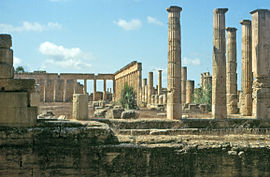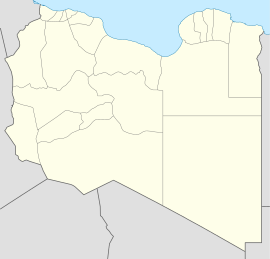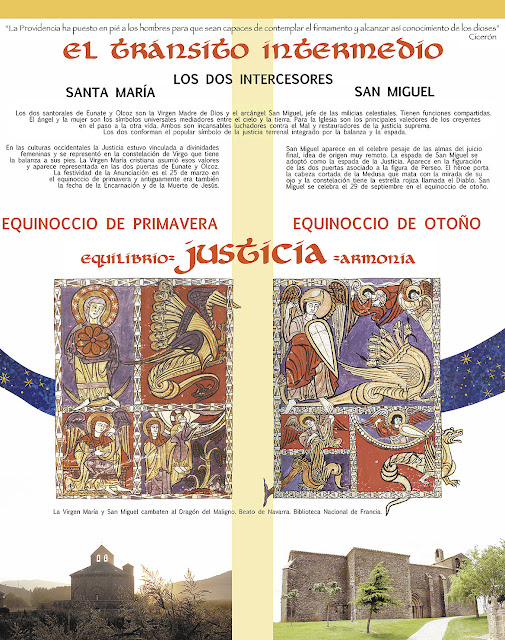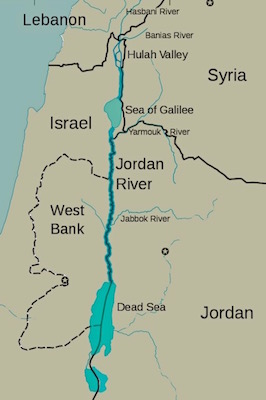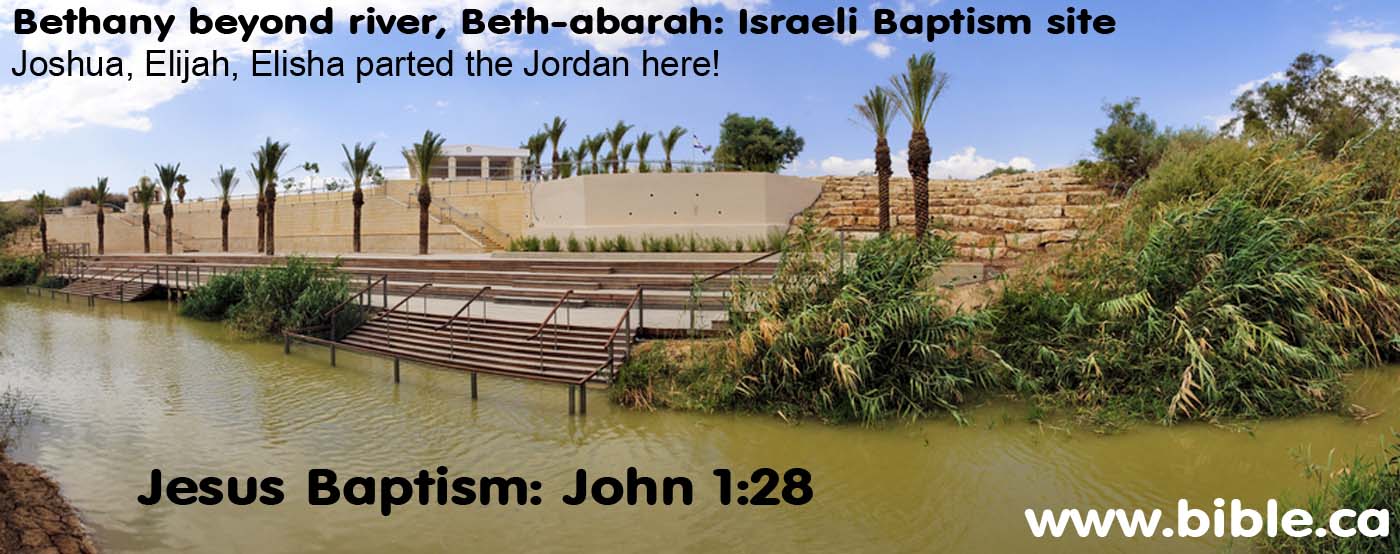|
|
General: LIBIA - DINAR / DENARIO / DAN / JUICIO / DAN BROWN / DA VINCI / LINAJE DE A-DAN
Choisir un autre rubrique de messages |
|
|
DINAR/DENARIO/DAN/JUICIO
LA MONEDA DE LIBIA, ES EL DINAR.
|
|
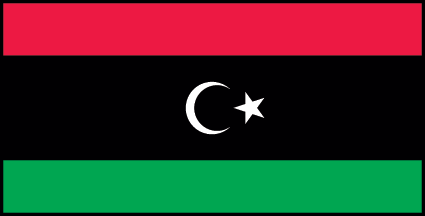
|
|
Nombre oficial
|
Al-Jamahiriyah al-Arabiyah al-Libiyah
|
|
Localización
|
26º 20' 6.36" N 17º 13' 41.99" E
|
|
Superficie
|
1.759.540 km2
|
|
Población
|
5.470.000 hab.
|
|
Razas
|
La población autóctona era bereber. En la actualidad, los árabes constituyen el 90%
|
|
Idioma
|
Árabe
|
|
Religión
|
islámica (oficial), sunnita
|
|
Capital
|
Trípoli (Tarabulus)
|
|
Gobierno
|
Congreso General del Pueblo es el máximo organismo de gobierno del país, con 2700 representantes
|
|
Moneda
|
Dinar libio
|
|
Fiesta nacional
|
1 de setiembre, Revolución (1969)
|
|
NUMERO 19/DAN/OPHIUCO/ JUSTICIA/ $$$ / SCORPION / SOPHIA/ SABIDURIA / NUMERO DE ORO PHI/ PUERTA DE ORO
|
|
|
 Premier
Premier
 Précédent
2 à 6 de 6
Suivant
Précédent
2 à 6 de 6
Suivant
 Dernier
Dernier

|
|
|
 Wednesday, April 15, 2009 Wednesday, April 15, 2009
Let us assume (and these are reasonable assumptions as we will further explain) these things:
1) that Salome, the mother of John and James, the sons of Zebedee, was the Virgin Mary’s sister — an assumption reached by comparing three verses: Mark 15:40 and Matthew 20:20; 27:56.
2) that John and James, the sons of Zebedee, were not given the names “sons of thunder” to flatter them; but rather because they were hot-tempered (and therefore unlovable) and always jockeying for special favor with Jesus, presumably their cousin by virtue of Mary being Salome’s sister. Indeed, the other disciples are often shown grumbling that John and James persist in asking Jesus if they will find special favor in the world to come.
3) that the apostle John, the son of Zebedee, who is one of two candidates for the writer of the Gospel of John, which by default makes him one of two candidates for the scholarly third-person identifier “the disciple whom Jesus loved,” was a fisherman’s son from Galilee and not a scholar who lived in Jerusalem and knew the high priests Annas and Caiaphas.
4) that Mary Magdalene does not deserve to be identified as “the disciple whom Jesus loved” by virtue of the fact that she is not a man named John, who would have written the Gospel of John, and by virtue of the fact that she is seen in the company of “the other disciple, the one whom Jesus loved” at the empty tomb with Peter.
5) that the home of John Mark and his mother Mary served as the home where the actual last supper took place — and, that this home was located near the Garden of Gethsemane, to which Jesus and Peter, James and John journey immediately following the last supper.
6) that when John and James flee the Garden of Gethsemane upon seeing Judas and the Roman soldiers arrive that they do not later become emboldened and proceed to Golgotha to witness the crucifixion of Jesus.
7) that John Mark of Cyrene knew Simon of Cyrene (as indicated by Mark’s naming of his two sons Rufus and Alexander), who helped to carry Jesus’ cross.
8) that the Virgin Mary would not have wanted to witness the torturous execution of her son Jesus.
9) that John Mark was a scholar, having been trained in Cyrene in north Africa to read and write classical Greek, Latin and Hebrew.
10) that John Mark wrote the Gospel of Mark.
11) that John Mark is the only man named John to be placed near Ephesus, according to a letter written by Paul to Timothy, who at the time was in Ephesus, near Patmos, where the book of the Revelation of Jesus was written by a man named John.
12) that the controversy of which man named John is the writer of the Gospel of John and therefore “the beloved disciple” has been a topic for debate even among laymen since the third century.
13) that Leonardo da Vinci, having had three years to paint The Last Supper (from 1495 to 1498), did not mistakenly leave in his painting a hand holding a dagger without an arm or person attached behind the back of Judas — something which the Da Vinci Code never addresses.
None of these are in any way outrageous assumptions, but quite plausible and already readily accepted by most Bible scholars. If we assume all of these things … we can go through the following vague references to a man named John and a woman named Mary and end up with the identity of the true beloved disciple, the writer of the Gospel of John.
Now let us turn our attention to 19 vague references to people which appear in the gospels of Mark and John. We believe that taking into account these first 12 assumptions above that we can demonstrate that all but two of these references are references to African scholar John Mark. We contend that two of the 19 references are made to John Mark’s mother Mary.
1) “A certain youth” is found in Mark 14:51-52. — These verses along with John 19:25-27 are KEYSTONE verses, in that they are the two passages from the gospels of Mark and John which indicate tampering with the original gospel manuscripts. This Mark passage sticks out like the proverbial sore thumb, because without identifying the “certain youth” and what he was doing in the vicinity of the Garden of Gethsamene it very obviously has nothing to do with the narrative. That is a clue that the original passage was altered by someone who wished to obscure John Mark, whom scholars tend to believe was the “certain youth” anyway.
These unspecific verses about a seemingly unrelated event on the night that Jesus was arrested serve as the keystone upon which all of the vague references in John’s Gospel must be overlaid and considered.
2) “The disciple whom Jesus loved” is found in John 13:23. — This we know is a man named John.
Jesus thought enough of the beloved disciple — and Peter knew it — that Peter should be compelled to nudge John — “the disciple whom Jesus loved” — and ask him to ask Jesus who it would be who would betray Jesus. John had a special relationship with Jesus, which went beyond being a mere disciple. That’s an important point. It is the closeness of the relationship between John and Jesus that has precipitated the use of the vague and obscuring language; in other words, as we shall see the vaguely identified John in subsequent passages, whom we say is John Mark, became necessary to the alterer of the original manuscripts if the alterer was to be successful. Of all of the references to the person who serves as Jesus’ defender, which we shall see next, we would expect these references to be clear, i.e., we would expect the disciple to be named, and he is not.
Peter, as close as he was to Jesus, felt compelled to ask John to ask Jesus who was going to betray Jesus. John clearly had a familial relationship with Jesus — they were that close. It had to be a unique and very special relationship, one based on mutual trust and understanding, how a home boy would feel toward another.
3) “Another disciple” is found in John 18:15. — This is a man who is a scholar, scribe and likely a priest, having been known to the high priests Caiaphas and Annas.
4) “This disciple” is found in John 18:15. — This is a man who is a scholar, scribe and likely a priest.
5) “This other disciple” is found once in John 18:16. — This is a man who is a scholar, scribe and likely a priest.
Why would the person who was willing to go to bat for Jesus be unnamed? Surely this man, whom we say is scholar John Mark, was not just a casual acquaintance of the high priests Caiaphas and Annas. They must have trusted him, otherwise he doesn’t get an audience. And we would have to say that John Mark may have come very close to winning Jesus’ freedom because of what they thought of John Mark. This John (John Mark) lived and worked in Jerusalem. Zebedee’s John was a fisherman from Galilee, as Peter was. If Peter would deny Jesus repeatedly … why would Zebedee’s John do any differently? In fact, Zebedee’s John was nowhere to be found, having fled with his brother James.
Clearly, the unnamed disciple was a special person. But apparently not special enough to be named. Was the unnamed disciple’s name removed? In other words, was John Mark’s name ever used, was it used in the original manuscript? We will probably never know, but a name doesn’t appear here, and it is jarring. Mark 14:51-52 is the keystone: this person is a youth, younger than the other disciples, which John Mark was; the name has apparently been removed in these verses, rendering them nonsensical, irrelevant; then why does this passage appear at all if it seemingly has no bearing on the story? These verses appear as subterfuge: Because if John Mark is not wearing his priestly white linen garment … then he cannot be “the other disciple” who serves as Jesus’ defense counsel. Only a scribe, i.e., attorney could have argued effectively on Jesus’ behalf. John Mark was a scribe. From the second century B.C.E. forward … all Jewish scribes were also priests. So the white linen makes sense. It is the hidden John Mark who is the only person who could play this role. He is the thirteenth disciple.
6) “The other disciple, the one Jesus loved” is found in John 20:2. — This person is with Peter at the empty tomb. This person outruns Peter to the empty tomb. This person is not Mary Magdalene.
This is a very critical reference to the unnamed disciple, because Mary Magdalene is in the same scene with this person, i.e., “the other disciple, the one Jesus loved” — therefore removing any likelihood that Mary Magdalene was herself the beloved disciple. This is a critical passage also because it describes “the other disciple” as outrunning Peter to the empty tomb, something a younger man would be expected to do. But when John Mark got to the empty tomb … he did not go in. He was frightened. That would change. John would become bold and take a second name, a Greek name, Marcus, which some have tried to say means “deformed fingers”; it means “Hammer,” which is a testament to John Mark’s newfound boldness after seeing his friend crucified. John Mark must have been hated, and so he has been obscured.
7) “The other disciple” is found in John 20:3. — This is the same person as the one above.
8) “The other disciple” is found in John 20:4. — Ditto.
9) “The other disciple” is found in John 20:8. — Ditto.
10) “The disciples” is found in John 20:10. — This is Peter and the other disciple above.
11) “Two other disciples” found in John 21:2. — It is uncertain who these two disciples are; but we know they are not the sons of Zebedee, John and James, who are previously named in the same sentence.
This is a critical reference, too — for it distinguishes two unnamed disciples from the two sons of Zebedee, John and James. A pattern by this point has been established: wherever John Mark appears … there are only vague references. “The other disciple” could not have been Zebedee’s John in any of these other instances, so we assume based on previous assumptions that this must be John Mark … and one other person. The second disciple may have been added to confuse us.
12) “The disciple whom Jesus loved” is found in 21:7. — This is the writer of the Gospel of John.
This reference is made in the way that a scholar would use such a reference to identify himself, in the third person. I suspect that those who wanted to obscure John Mark took a cue from this sort of reference and the one in chapter thirteen in John’s Gospel, when John Mark as a scholar refers to himself in the third person. Those who tampered with these other verses took advantage of the ambiguity … to obscure the scholar.
13) “The other disciples” is found in John 21:8. — It is uncertain who these other disciples are.
14) “The disciple whom Jesus loved” is found in 21:20. — This is the writer of the Gospel of John.
15) “This disciple” is found in John 21:23. — This is the writer of the Gospel of John, whom Jesus says will likely not die. This person very likely lives to write the book of the Revelation of Jesus.
This is Jesus’ reply to Peter, who has asked Jesus if one of the disciples, whom we contend is John Mark, will escape martyrdom: “What is it to you if this disciple is not martyred? You worry about yourself.” This in effect is what Jesus says when Peter wants to know if the rumor is true that “this man,” “this disciple,” according to the grapevine, is not going to be martyred. Peter would have never raised the issue within earshot of Zebedee’s John if this person had been Zebedee’s John. And Jesus would never have played favorites, showing favoritism for Zebedee’s John or James over the other disciples. John and James, the sons of Zebedee, were also the sons of Salome, the sister of Jesus’ mother Mary, making John and James Jesus’ cousins. What cousin is beloved? What cousin is chosen over another cousin and called beloved?
16) “This disciple who testifies to these things” is found in John 21:24. — This person is the writer of the Gospel of John.
Here again, John Mark refers to himself in the third person as a scholar would do. Only John Mark is a scholar. I don’t know why other Bible scholars have not consulted the Coptic biography of John Mark written by Pope Shenouda III, the patriarch of the Holy See of St. Mark, but they haven’t (it appears in our “sky links” above under “Biography of St. Mark,” conveniently enough. New Testament commentaries which I have read pertaining to John Mark doubt that he was even the founder of the Coptic church in Alexandria, Egypt. The Coptic biography of John Mark is unequivocal in stating all that John Mark was, and he was a considerable force of early Christianity. The only thing the Copts get wrong has to do with the alleged martyrdom of John Mark, which cannot have occurred. For he lived on to write Revelation. Zebedee’s John, on the other hand, was expecting martyrdom … because Jesus told him and James that they would drink from the same cup as Jesus.
17) “The other Mary” is found in Matthew 28:1. — It is uncertain who this woman is, but note that she is described in the same way as “the other disciple.”
This Mary can be one of many other women named Mary, and there is a passel of them — which is why we should expect a more precise description of just which Mary this is. But it is a vague reference to this Mary, who, very notably, is in the presence of Mary Magdalene, who is already suspect certainly, not being the beloved disciple — and she is not because John Mark, the other disciple who is with her at the empty tomb, is. It is reasonable to assume that Mary, John Mark’s mother, would also be treated obscurely if any woman named Mary would be … for this John and Mary are the actual mother and son who appear at the foot of Jesus’ cross in John 19:25-27.
18) “The other Mary” is found in Matthew 28:61. — Ditto.
When these verses are cross-referenced, laid one on top of the other, with an understanding of motivations and John Mark’s actual background, national and educational, we come out at the distilled end with only one person who fits the criteria in all of these verses. And that is John Mark. It can be no one else. Bible scholars for years have avoided even weighing in on this subject, because it appeared unsolvable.
19) “The disciple whom Jesus loved” and Mary, the mother of Jesus” is found in John 19:25-27.
This famous passage reads as follows: “When Jesus saw his mother there, and the disciple whom he loved standing nearby, he said to his mother, ‘Woman, behold your son,’ and to the disciple, ‘Behold your mother.’ From that hour, this disciple took her into his home.”
Let’s assume the beloved disciple in this instance is John, the son of Zebedee, who fled Gethsemane earlier, abandoning Jesus. In Matthew 13:54-57, we’re presented with the strongest evidence as to why this famous passage in John as it is presently written doesn’t ring true. It reads: “Coming to his hometown, he began teaching the people in their synagogue, and they were amazed. “Where did this man get this wisdom and these miraculous powers?” they asked. “Isn’t this the carpenter’s son? Isn’t his mother’s name Mary, and aren’t his brothers James, Joseph, Simon and Judas? Aren’t all his sisters with us? Where then did this man get all these things?” And they took offense at him. But Jesus said to them, “Only in his hometown and in his own house is a prophet without honor.”
Why would Jesus ask Zebedee’s John, a hot-tempered firebrand against whom the other disciples often grumbled, to take care of his mother Mary, when we know from this passage in Matthew that Jesus had at least four brothers, one of whom being James, who became the head of the church in Jerusalem, and sisters as well? This passage in John is even further made questionable by the possibility that the Virgin Mary was likely the aunt of the apostle John, as we have said, with Mary being the sister of Salome, whose sons were James and John, the sons of Zebedee.
Besides, as we have already stated … once Judas and the Roman soldiers arrive in Gethsemane, James and John, the sons of Zebedee, run for their lives, presumably not to be seen again until the book of Acts, when we learn that James, alas, is martyred, just as Jesus predicted. But what of John? James and John were inseparable. It is highly doubtful that James and John, having been told earlier by Jesus that they would be martyred … it is highly doubtful that they would have suddenly become bold enough to ascend Golgotha and watch Jesus as he was executed. Neither would Peter have been bold enough to ascend to Golgotha. And then of course there is the inescapable fact that John Mark is placed atop Golgotha, having followed as an eye-witness Jesus and Simon of Cyrene (very apparently known to John Mark of Cyrene), who would carry Jesus’ cross.
If the disciple whom Jesus loved in this instance was Zebedee’s John, this passage is odd. It makes sense if John Mark, who is already present at Golgotha, is the disciple whom Jesus loved. What Jesus then appears to be saying when he tells the two to “behold” one another … is not to perceive one another as mother and son anew … but to look after one another in Jesus’ physical absence. And this John Mark does, leaving Paul on the mission field to go home to Jerusalem, which caused the famous rift between Paul and John Mark. You’ll recall that Barnabas, after this fight, sides with John Mark … and they leave for Cyprus. Barnabas was the nephew of Mary, the mother of John Mark. And so Barnabas, too, may well have been an African. We also know that he was wealthy, as John Mark and his mother Mary apparently were.
Let us recap what we’ve said here: This passage, then, along with Mark 14:51-52, is a keystone passage, because it has apparently been tampered with, changing the person Mary, the mother of John Mark, to Mary, the mother of Jesus. John Mark and Mary were Jesus’ benefactors: wealthy Africans and unsung heroes of early Christianity. It is hard to imagine that Jesus’ mother would have wanted to be anywhere near Golgotha to see her son tortured and killed. And, as for John the apostle, he could not possibly be here, neither he nor his James, for they fled and abandoned Jesus in the Garden of Gethsemane; nor is Peter here, he having denied even knowing Jesus. John Mark, as evidenced in Mark 15:21, is the only man named John to be present at Golgotha. And we know this because John Mark in the Gospel of Mark describes Simon of Cyrene, whom John Mark would have known along with Simon’s two sons Rufus and Alexander, because John Mark was himself from Cyrene. Only John Mark witnesses the selection of Simon and accompanies Simon and Jesus to the top of Golgotha.
Granted, we are making some pretty large assumptions here. But we’re being realistic when we say that John Mark was at the cross and Zebedee’s John along with Peter and James very likely were not. The passage makes sense if it is John Mark with his actual mother Mary.
Notably (and interestingly) John Mark is placed at Jesus’ cross despite the statements of Papias that John Mark “neither heard nor accompanied Jesus,” these beliefs of Papias coming on the word of a mysterious man named John, apparently known as Presbyter John.
This explanation makes an odd verse suddenly make sense. Jesus told actual mother and son to “behold” or look out for one another in his physical absence. It is of course possible that John Mark may have been standing with Mary, the mother of Jesus, but if Mary, the mother of Jesus, was John Mark’s aunt … it would make this verse odd. We have to assume that John the apostle never took Jesus’ mother to his home in Galilee to care for her, and so the Virgin Mary would never had gone to Ephesus, as Mary Magdalene is alleged to have done, where both are believed to have lived, died and been buried.
A German nun in 1951 initiated the apparently false rumor that the Virgin Mary lived in Ephesus with John, the son of Zebedee, and died there. But, of course, we have the tomb of the Virgin Mary in Jerusalem to refute that.
It bears noting that if this pair was John the apostle and Mary, the mother of Jesus, verse 27, which indicates they left for the beloved disciple’s home at “that very hour,” would suggest that it would have been very unlikely for John, who lived in Galilee, sixty miles to the north, to make the return trip to Jerusalem to be present at the empty tomb — which offers more validation that our interpretation of these verses is accurate.
FINAL NOTE: The Last Supper, as the painted is interpreted by the Da Vinci Code, we contend perpetrates a lie about the true beloved disciple, John Mark, who actually lived in the home where the actual last supper was held. Recognizing this and recognizing that the patron of The Last Supper was Ludovico Sfroza, a.k.a. “the Moor,” whose “justice,” Leonardo said, “was as black as he himself,” it is at least possible that Ludovico may have known about the biblical controversy over which man named John was the beloved disciple, and that one of them was an African. And we say this because in the painting where there should be a man named John being nudged by Peter there is a woman, whom the Da Vinci Code says is Mary Magdalene. She could be anyone. But is she John? No, we don’t think so, and that is because of the presence of the hand behind Judas’ back with no arm or person attached to it. The painting has obviously to our mind been repainted, and it very likely may have been to paint out Ludovico the Moor’s little joke of including John Mark, the hidden thirteenth disciple about whom we know so little. The painting disintegrated within decades after it was painted, being painted presumably on dry plaster, which would seem to be nothing that the master Leonardo would do in creating a fresco. A fresco is only a fresco if it is painted using wet plaster. The French invasion of Milan in 1499, which sent Ludovico and Leonardo packing, would have given anyone who wished to a chance to repaint the fresco, painting out one John or perhaps two, including John Mark, and also repainting Jesus. It is notable that the figure believed to be Mary Magdalene and Jesus himself are of a lighter pigment and style than the rest of the figures in the painting and their expressions, being demure and detached, do not fit the scene. Are The Last Supper then and the Da Vinci Code part of the coverup, which is like the one which appears in the New Testament gospels to obscure John Mark? And who would be responsible for a coverup going as far back possibly as the first century? Papias’ cryptic statement that “the presbyter John” told him that Mark was not a follower or hearer of Jesus … may be a clue.
The presbyter John of Papias’ day in the second century and/or Prester John, a mythical character about whom fanciful stories were told, are suspicious figures, indeed. But are they both fabrications or are they real? They never found Prester John, and, notably stopped looking for him in the seventeenth century reportedly in Ethiopia. Prester John, an Adamic figure, who was supposed to have been a mystical king and priest overseeing a land rich with gold and exotic animals, may have been subterfuge to convince people that there was nothing resembling Eden to be found in Ethiopia, and science today tells us otherwise.
Race is irrelevant, as God is invisible, spirit, indwelling all things. But as we can conclude from the conclusion we reach, race obviously has been the motivation to hide John Mark, but why? Because he was an African and Jesus’ closest friend? You can draw your own conclusions.
http://tanata.squarespace.com/journal/2009/4/15/arguments-for-john-mark-as-the-beloved-disciple.html |
|
|
|
|
Cirene
De Wikipedia, la enciclopedia libre
Cirene fue una antigua ciudad griega en la actual Libia, la más importante de las cinco colonias griegas de la región, a la que dio el nombre de Cirenaica, utilizado todavía hoy en día. Está situada en el valle de Djebel Akhdar. En esta ciudad nacieron numerosos matemáticos o filósofos, como Eratóstenes o Sinesio de Cirene, entre otros.
Las ruinas de Cirene fueron declaradas Patrimonio de la Humanidad por la Unesco en el año 1987.
Historia de Cirene en Libia[editar]
Cirene fue fundada por los griegos venidos de Tera, actual Santorini, siguiendo los consejos del Oráculo de Delfos, conducidos por Aristóteles de Tera (posteriormente Bato) sobre el 632 a. C.[1]
Bato después de fundar una colonia en un islote de la costa oriental de Cirenaica (de nombre Platea, en el golfo de Bomba) se trasladó al distrito de Azilirs, en tierra firme, donde los colonos estuvieron seis años hasta que hallaron un emplazamiento mejor en la región de Irasa donde fundó Cirene, más al interior (631 a. C.), e inició la dinastía de los Batíadas que tuvo ocho reyes (y un usurpador). La ciudad fue fundada en el territorio de la tribu libia de los asbistes (o asbistis) y dominaba las tierras más fértiles y con agua. La fundación de la ciudad está explicada detalladamente en el libro IV de las Historias de Heródoto.[2] La información del historiador de Halicarnaso ha sido atestiguada por el hallazgo de un texto epigráfico del siglo IV a. C., llamado Estela de los fundadores, que hace mención al nexo que unía Tera con Cirene.[3]
Cirene se convirtió pronto en la ciudad principal de la región libia comprendida entre Egipto y Cartago, aumentando las relaciones comerciales con todas las ciudades griegas. El punto álgido de su prosperidad tuvo lugar bajo sus propios reyes en el siglo V a. C.
Reyes Batíadas[editar]
La colaboración con los libios fue intensa y produjo una mezcla importante. Heródoto dice que el nombre de Bato era una palabra libia que quería decir "rey". Los libios estaban excluidos del poder político. Los Batíadas fundaron las colonias de Tauquira (actual Tocra), Hespérides y después la Barca, que juntamente con la propia Cirene y su puerto, Apolonia, formó la original Pentápolis Libia.
Bato II invitó a griegos a establecerse en la región y les dio tierras que le arrebató a los libios. Esto provocó la revuelta de los libios que pidieron ayuda al rey de Egipto, que envió un ejército, pero los egipcios fueron rechazados en la región de Irasa y derrotados completamente (lo que provocó indirectamente el derrocamiento del faraón egipcio Apries). Bajo el faraón Amasis, se estableció una alianza entre Cirene y Egipto y el rey se casó con Laódice, princesa Batíada.
El hijo de Bato II, Arcesilao II, gobernó como un tirano y provocó la revuelta de los griegos dirigidos por sus hermanos, que se establecieron en la Ciudad de Barca, y los libios se rebelaron. Para sofocar la rebelión murieron siete mil soldados. Su hermano Learco le mató y se proclamó rey, pero Bato III conseguió restaurar la línea legítima.
Los griegos de Cirene, bajo instrucciones del oráculo de Delfos, pidieron ayuda a Demonax de Mantinea que llegó a Cirene y estableció una nueva constitución que quitó el poder a los reyes dejándolos como figuras representativas, con funciones religiosas, pero conservando sus dominios privados; el poder político limitado a los descendientes de los colonos originales, fue ampliado al resto del pueblo griego que fueron divididos en tres tribus: los therenios (con la clase baja libia agregada), los peloponesios y cretenses; los egeos; se creó un senado, cuyo presidente era el rey; la constitución tenía similitudes con la de Esparta y existían unos éforos y una policía de 300 hombres armados (similares a los Hippeis de Esparta).
A la muerte de Bato, hacia el 530 a. C., le sucedió su hijo Arcesilao III. Este rey tuvo buenas relaciones con la ciudad de Barca y se casó con la hija del rey Alazir de esta ciudad, pero junto con su madre Feretima (Pheretime), intentó derrocar la nueva constitución y fracasó habiendo de marchar al exilio, pero volvió al frente de un grupo de mercenarios y emigrantes procedentes de Jonia y entró en Cirene ejerciendo una cruel venganza sobre sus oponentes; para asegurar su poder envió una embajada a Menfis y se declaró vasallo de Cambises II de Persia, y se comprometió a pagarle un tributo anual y a hacerle un regalo; este regalo fue considerado insuficiente por el rey persa que tiró despectivamente a sus soldados. Arcesilao consideró que había roto las instrucciones del oráculo de Delfos, que le habían recomendado moderación en la victoria, y para cumplir los deseos divinos se retiró a Barca, gobernada por su suegro Alazir, pero en esta ciudad unos exiliados de Cirene, ayudados por un partido local, mataron a Arcesilao y a Alazir en la plaza del mercado. Feretima, la madre de Arcesilao, en venganza, pidió ayuda a Ariandes, sátrapa persa de Egipto (nombrado por Cambises II y que conservó el cargo bajo Darío I). El sátrapa reunió un fuerte ejército y una flota y envió una embajada a Barca preguntando quién o quiénes habían sido los asesinos, pero la gente de Barca asumió colectivamente la responsabilidad. Ariandes envió entonces el ejército y asedió la ciudad durante nueve meses, y finalmente los persas la ocuparon mediante una estratagema (510 a. C.). Los ciudadanos sospechosos de simpatizar con el asesinato de los reyes fueron empalados y las murallas se llenaron de gente empalada y entre ellos los miembros de la dinastía Batíada de Barca, de los que se sospechaba eran culpables. Feretima, que había acompañado a los persas hasta Barca, volvió a Egipto con el ejército persa, pero murió de una enfermedad infecciosa.
De esta crisis salió la restauración de los Batíadas en Cirene, que puso fin a la constitución de Demonax y a sus instituciones. Reinaron entonces Bato IV el Bello, con un largo reinado, y después Arcesilao IV, cuya casta de caballos libios era célebre y que tenía tendencias tiránicas. Arcesilao quiso destruir a la nobleza local y basar su apoyo en un ejército mercenario. Cuando murió se proclamó la república y su hijo, Bato V, huyó a Hespérides donde fue asesinado y su cabeza tirada al mar como símbolo de la extinción de la dinastía (hacia el 450 a. C.).
República de Cirene[editar]
Tras el 460 a. C. se convirtió en República. Del período republicano se sabe poco; se incrementó el número de tribus y se dieron nuevas tierras a los colonos; el partido democrático fue hegemónico y tuvo enfrentamientos con rivales políticos, lo que llevó al ejercicio de la tiranía por algunos, como Aristón y Nicócrates.
En 331 a. C., Cirene hizo un tratado con Alejandro Magno, por el que fue una dependencia autónoma de Macedonia, y a la muerte del rey, y después de un breve gobierno de Tibrón, pasó al dominio de Ptolomeo I Sóter de Egipto.
Dinastía Ptolemaica y dominación romana[editar]
Los Ptolomeos favorecieron el puerto de Cirene, Apolonia, por encima de la propia Cirene, que entró en decadencia. Finalmente la región fue una especie de reino lágida separado y a la muerte del rey en 95 a. C., fue legada por testamento a Roma. Las cinco ciudades de la región, y entre ellas Cirene, continuaron funcionando como repúblicas independientes, bajo protectorado romano, pero hubo luchas con otras ciudades y finalmente los romanos anexionaron el territorio y le convirtieron en provincia (75 a. C.).
En tiempos del emperador romano Vespasiano, Cirene fue constituida en colonia romana con el nombre de Flavia Cirene. Cuando llegó al poder Teodosio I el Grande, Cirene empezó a formar parte del Imperio Romano de Oriente.
Allí nacieron: Aristipo, médico y filósofo, fundador de una escuela; Carnéades, fundador de la Nueva Academia de Atenas, el poeta Calímaco, supuesto descendiente de la dinastía Batíada, y Sinesio, que fue obispo de Apolonia, Simón de Cirene, que ayudó a Jesús a cargar la cruz hacia el Calvario.
Asentamiento bizantino y musulmán[editar]
Cuando el Imperio Romano de Oriente empezó a llamarse Imperio bizantino, el nuevo reino se dividió en diferentes mancomunidades, y Cirene se convirtió en la segunda ciudad más poblada de la mancomunidad de Egipto, por detrás de Alejandría. Pero ya en el siglo VII, Cirene empezó a formar parte del imperio musulmán.
Con el tiempo, los musulmanes abandonaron Cirene para dirigirse al oeste y conquistar Hispania. Cirene no estuvo habitada durante siglos ya que había quedado fuera de las rutas comerciales del Mar Mediterráneo, por lo que acabó desapareciendo del mapa antiguo.
Las ruinas de la ciudad son importantes y permiten ver los restos de calles, el acueducto principal, templos, teatros y tumbas, aunque quedan también algunas esculturas y pinturas. La vía que unía Cirene con la cercana ciudad de Apolonia de Cirene aún se puede seguir.
|
|
|
|
|
SEGUN LOS COPTOS JUAN MARCOS ERA LIBIO
Marcos el Evangelista
De Wikipedia, la enciclopedia libre
| San Marcos Evangelista |

San Marcos el evangelista |
| Evangelista, mártir |
| Nombre |
Juan Marcos |
| Nacimiento |
Siglo I
Cirene, Pentápolis norteafricana, de acuerdo a la tradición copta[1] |
| Fallecimiento |
25—26 de abril de 68
Alejandría |
| Venerado en |
Iglesia ortodoxa copta
Iglesia ortodoxa
Iglesia católica
Iglesias católicas orientales
Iglesia anglicana
Luteranismo |
| Festividad |
25 de abril |
| Atributos |
León en el desierto; obispo en un trono decorado con leones; hombre ayudando a navegantes venecianos; hombre sosteniendo un libro con "Pax tibi, Marce (Evangelista meus)" escrito en él; hombre sosteniendo una palma y un libro; hombre con un libro o pergamino acompañado por un león alado; hombre con un cabestro alrededor de su cuello; hombre escribiendo o sosteniendo su evangelio; rescatando a esclavos cristianos de los sarracenos |
| Patronazgo |
Arica, Mainar, Egipto , Venecia, San Marcos (Nicaragua), San Marcos (Guatemala), Ciudad de San Marcos, San Marcos (San Marcos) Hinojares, Mancha Real, bárristers y otros; ver artículo |
| [editar datos en Wikidata ] |

Bandera de San Marcos Evangelista.
San Marcos Evangelista (en griego: Μάρκος; en latín: Mārcus; en copto: Μαρκοϲ; en hebreo: מרקוס) (siglo I) es considerado tradicionalmente el autor del Evangelio de Marcos y el fundador y primer obispo de la Iglesia de Alejandría.
San Marcos en el Nuevo Testamento y en otras fuentes[editar]
Suele identificársele con Juan, llamado Marcos. Este personaje aparece varias veces en los Hechos de los Apóstoles. Se le cita por primera vez en Hechos 12:12, cuando Simón Pedro, milagrosamente liberado de la cárcel, se refugia en casa de María, madre de "Juan, por sobrenombre Marcos". Acompañó a Pablo de Tarso y a Bernabé en el primer viaje de Pablo (Hechos 13:5), pero se separó de ellos cuando llegaron a Panfilia, regresando a Jerusalén (Hechos 13:13 en estos versículos se hace referencia a él simplemente como "Juan"). Cuando Pablo iba a iniciar su segundo viaje, tuvo una grave disputa con Bernabé a propósito de "Juan, llamado Marcos": Bernabé quería que fuese con ellos, pero Pablo se negaba, ya que les había abandonado en el viaje anterior. Pablo y Bernabé terminaron por separarse, y Marcos acompañó al segundo en su viaje a Chipre (Hechos 15:37-39).
No está claro si este personaje, "Juan, llamado Marcos" es el mismo al que se hace referencia en algunas epístolas atribuidas a Pablo, concretamente en 2Timoteo 4:11, Colosenses 4:10, Filemon 1:24 y en la Primera Epístola de Pedro (1Pedro 5:13). En Colosenses se dice de él que es primo, o sobrino, de Bernabé, lo que podría explicar que éste disputase con Pablo acerca de Marcos.
En el final de la Primera Epístola de Pedro, éste se refiere a "mi hijo Marcos". Mientras que las iglesias copta, católica y ortodoxa aseguran que se trata de un hijo espiritual (es decir, que Marcos hubiese sido bautizado por Pedro) o que simplemente Pedro le tenía mucho cariño, varios teólogos protestantes no tienen inconveniente en interpretar que podría tratarse de un hijo físico.
Según el Evangelio que se le atribuye, cuando Jesús fue apresado en el Huerto de los Olivos, le seguía un joven envuelto en una sábana, habiendo especulado algunos con la posibilidad de que este joven fuera el mismo Juan Marcos.
La tradición dice que Marcos evangelizó como Obispo de Alejandría, en Egipto, donde realizó varios milagros y estableció una iglesia y su famosa escuela cristiana, nombrando un obispo, tres presbíteros y siete diáconos y murió allá como mártir en el año 68, un 25 de abril.
Según la tradición, la Iglesia Copta de Etiopía tiene su origen en las prédicas de San Marcos, autor del Segundo Evangelio en el siglo I, que llevó el cristianismo a Egipto en la época del emperador Nerón.
Los Hechos de San Marcos, un escrito de mitad del siglo IV, refieren que San Marcos fue arrastrado por las calles de Alejandría, atado con cuerdas al cuello. Después lo llevaron a la cárcel y al día siguiente le volvieron a aplicar el mismo martirio hasta que falleció. Luego echaron su cuerpo a las llamas, pero los fieles lograron sacarlo y evitar su destrucción.
Atribución del Evangelio de Marcos[editar]
Marcos es considerado por la tradición cristiana el autor del evangelio que lleva su nombre. Puesto que él no fue discípulo directo de Jesús basó su relato -siempre según la tradición- en las enseñanzas de Pedro. El autor más antiguo que asignó a Marcos la autoría de este evangelio fue Papías de Hierápolis, en la primera mitad del siglo II, en un testimonio citado por Eusebio de Cesarea.
«y el anciano decía lo siguiente: Marcos, que fue intérprete de Pedro, escribió con exactitud todo lo que recordaba, pero no en orden de lo que el Señor dijo e hizo. Porque él no oyó ni siguió personalmente al Señor, sino, como dije, después a Pedro. Éste llevaba a cabo sus enseñanzas de acuerdo con las necesidades, pero no como quien va ordenando las palabras del Señor, más de modo que Marcos no se equivocó en absoluto cuando escribía ciertas cosas como las tenía en su memoria. Porque todo su empeño lo puso en no olvidar nada de lo que escuchó y en no escribir nada falso». (Eusebio, Hist. Ecl. iii. 39).
Desde el siglo II se dio por sentado que Marcos era el autor de este evangelio. Aunque es imposible tener ningún tipo de certeza a este respecto, se ha aducido convincentemente que no hay ninguna razón por la cual los primitivos cristianos tuvieran que adjudicar la autoría de este evangelio a un personaje oscuro que no fue discípulo directo de Jesús, en lugar de atribuírsela a uno de los apóstoles.

Restos de San Marcos Evangelista en Venecia.
En el 828, las reliquias atribuidas a San Marcos fueron llevadas de Alejandría por navegantes italianos, que las trasladaron a Venecia, donde se conservan en la Basílica de San Marcos, construida expresamente para albergar sus restos. Los coptos creen que la cabeza del santo quedó en Alejandría. Cada año, en el día 30 del mes de Babah, la Iglesia Copta conmemora la consagración de la iglesia de San Marcos, y la aparición de la cabeza del santo en la iglesia copta de San Marcos, en Alejandría, donde se conservaría su cabeza.
Iconografía[editar]

Iconografia de San Marcos Evangelista.
Se asocia a San Marcos con el león porque su Evangelio empieza hablando del desierto, y el león era considerado el rey del desierto y porque su Evangelio empieza hablando del río Jordán y a sus alrededores había muchas fieras, entre ellas el león. También se dice que es el león porque en su Evangelio comienza hablando de Juan el Bautista como "Voz que clama en el desierto", voz que sería como la de un león.
La Iglesia católica celebra su fiesta el 25 de abril.
Patronazgos[editar]
San Marcos es el patrono de Venecia desde el año 828, sustituyendo a San Teodoro. La historia cuenta que dos mercaderes, Buono Tribuno da Malomocco y Rustico da Torcello robaron sus reliquias de su tumba de Alejandría en Egipto y las escondieron en una carga de carne de cerdo para que los guardias musulmanes no lo descubrieran. Cuando llegaron a Venecia, lo donaron al Dux. Giustiniano Partecipazio que las colocaría en el castillo. Inmediatamente se comenzó a construir un santuario siguiendo el modelo de la basílica de los Doce Apóstoles de Constantinopla, la cual fue consagrada en el año 832. Un siglo más tarde fue destruida el año 976 por un incendio durante la insurrección del Dux Candiano IV. La antigua iglesia de san Teodoro presentaba una topología de planta de cruz griega inscrita en el espacio central. Este tipo de planta estuvo difundida en Oriente durante el siglo VII como las iglesias de la Dormición de Nicea, San Nicola di Mira, la iglesia de la Virgen de Haks y diversos ejemplos en Armenia. Los restos de la antigua iglesia parece ser que se vieron englobados en la nueva San Marcos construida entre 1063 y 1094.

Imagen de San Marcos venerada en Nicaragua.
San Marcos Evangelista es el santo patrono de San Marcos Nicaragua.
La verdadera historia de cómo llegó este santo a este pueblo nadie la sabe en realidad. Algunos “historiadores” lo atribuyen al padre español de apellido Osorio, que llegó al pueblo a comienzos del siglo 19, tuvo la premonición de que iba a ocurrir un sismo de proporciones gigantescas, por lo cual se arrodilló en el lugar en donde ahora se encuentra la iglesia exclamando: ¡San Marcos, sálvanos! y en virtud de no haber ocurrido el terremoto, el pueblo fue dedicado al Evangelista. La leyenda narra que a comienzos del siglo 19, una tarde, unos lugareños que araban la tierra bajaron a traer agua a las pilas de Sapasmapa y se encontraron una imagen, que llevaron al cura del pueblo, el padre Casiano Campos, quien declaró que era San Marcos Evangelista. De esta forma, la primera iglesia se construyó, dedicada a San Marcos, a comienzos del siglo 19 por el padre Eduardo Urtecho.
Las fiestas patronales en honor a San Marcos se celebran el 24 y 25 de abril, en estas fiestas locales se acostumbran los bailes folclóricos como: El Gueguense, El Toro Huaco, Las Inditas y La vaquita. En estas fiestas es costumbre repartir a los fieles devotos comidas típicas como el picadillo y la chicha de maíz.
El día 24, la víspera de la fiesta del santo, se realiza el famoso «Tope de los Santos», en donde la imagen de San Marcos se reúne con la Virgen de Montserrat, patrona de La Concepción; San Sebastián, patrono de Diriamba, y Santiago, patrono de Jinotepe. San Marcos se dirige a las pilas de Sapasmapa, lugar de añejos enfrentamientos con los habitantes de La Concepción en donde se “topa” con la Virgen de Montserrat, luego se dirige al mojón carretera San Marcos-Jinotepe en donde se encuentra con Santiago y San Sebastián. Luego los cuatro se dirigen al pueblo en donde entran con pompa y circunstancia a la iglesia.
http://es.wikipedia.org/wiki/Marcos_el_Evangelista
|
|
|
|
|
32. Génesis 30:6 Dijo entonces Raquel: Me juzgó Dios, y también oyó mi voz, y me dio un hijo. Por tanto llamó su nombre DAN.
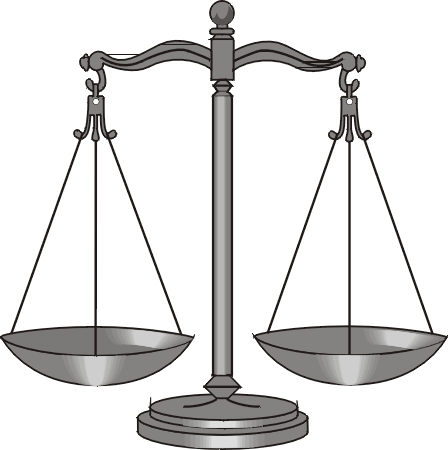
- Mateo 6:33: Mas buscad primeramente el reino de Dios y su JUSTICIA, y todas estas cosas os serán añadidas.
| Reply |
Message 10 of 10 on the subject |
|
Olcoz-Eunate y la Astrología II: Apocalipsis y Escatología
Que sea la constelación de Virgo el referente astrológico constructivo de San Miguel de Olcoz y Santa María de Eunate tiene igualmente unos componentes simbólicos derivados del Apocalipsis de Juan. Ello se debe a que María fue asimilada a la "mujer vestida del sol, con la luna bajo sus pies, y sobre la cabeza una corona de doce estrellas" (Ap 12,1) que está a punto de dar a luz a un niño. La Gran Serpiente (dragón) quiere aniquilar a ambos pero el arcángel san Miguel y su ejército celestial le derrota. Esta escena visionaria fue representada de múltiples formas a lo largo del Medievo y posteriormente.
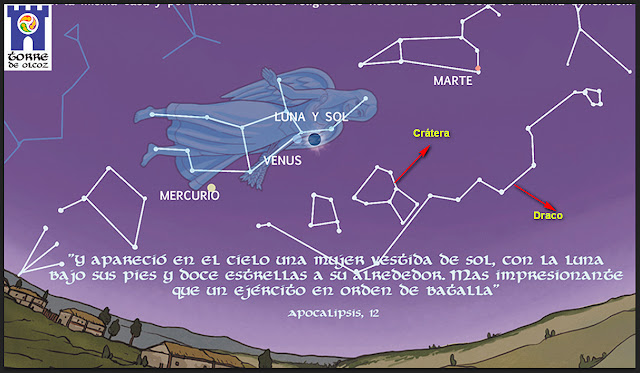 |
| Visualización astrológica de los paneles de Torre Olcoz (Jesús Zulet) |
"Hubo un gran combate en los cielos. Miguel y sus ángeles lucharon contra el Dragón. También el Dragón y sus ángeles combatieron, pero no prevalecieron y no hubo ya lugar en el Cielo para ellos. Y fue arrojado el Dragón, la Serpiente antigua, el llamado Diablo y Satanás, el seductor del mundo entero; fue arrojado a la tierra y sus ángeles con él." (Ap. 12,7-9)
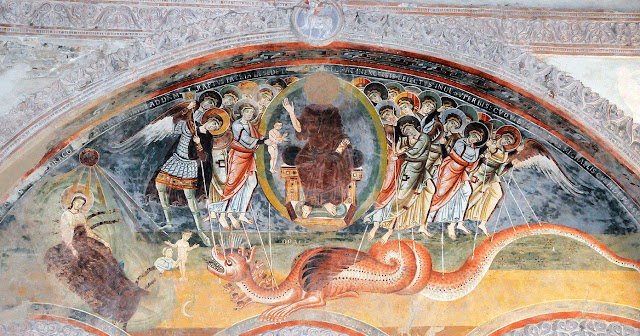 |
| Escena apocalíptica, frescos de la iglesia de San Pietro al Monte (Civitate-Italia). Siglo XII. |
En esta ascripción alegórica de la "mujer vestida de sol" con la Virgen María podemos encontrar, en la red de las "imágenes arquetípicas", a la Virgen que cantara Virgilio en su IV Égloga y que iba a dar a luz a un Mesías que traería consigo una nueva Edad de Oro. La Virgen virgiliana era Astrea, la diosa de la Equidad-Justicia-Orden que ascendió a los cielos desilusionada de la humanidad durante la Edad del Bronce, y que durante la Edad de Oro enseñaba en las ciudades y en la Edad de Plata a los aldeanos de las montañas. Mas la Astrea virgiliana fue equiparada con la Virgen María y su Puer Avatar con Jesús. Asimismo, en el Apocalipsis, la derrota de la Serpiente Antigua es el preludio de los acontecimientos que concluirán con el descenso de la Jerusalén Celeste (y de la Edad de Oro del Paraíso Celestial, por tanto).
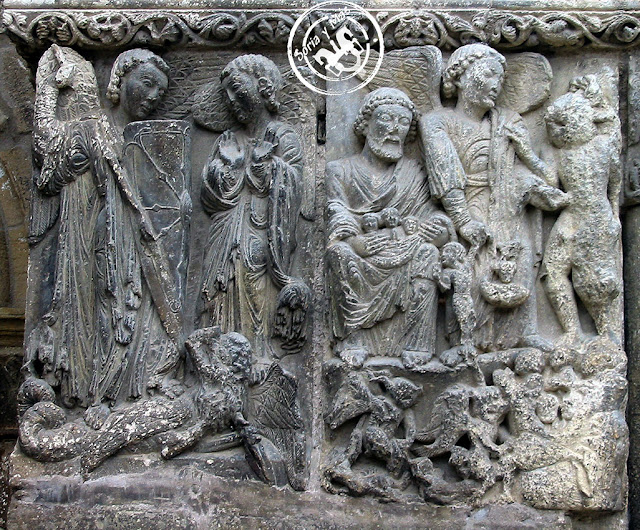 |
| Pasajes escatológicos con el arcángel Miguel, en la iglesia navarra de San Miguel en Estella (Camino de Santiago como Eunate y Olcoz, y no muy lejos de ellas). |
Estas concatenaciones simbólicas se difundieron durante la Edad Media así que no es extraño que fuesen conocidas por los promotores-patrones de las iglesias de Olcoz y Eunate, y es fácil así comprender el trasfondo apocalíptico de la advocación de ambos templos a Miguel Arcángel y a María, como los ha sabido igualmente mostrar Jesús Zulet (véase panel siguiente suyo)
Asimismo existe un trasfondo escatológico puesto que San Miguel es el psicopompo en el Más Allá y quien pesa las obras buenas y malas en la balanza (tema ya presente en Egipto), y María es la Gran Mediadora en el Más Allá (además su antecesora astrológica, Astrea, era la diosa de la Justicia). Y abundando en lo escatológico, se sabe documentalmente que Santa María de Eunate era ya en 1219 sede de una cofradía de ánimas de los pueblos de Valdizarbe y entorno inmediato, como lo descubriera José María Jimeno Jurío. Además, como he dejado claro en otro lugar, buena parte de la iconología de Eunate puede adscribirse a los escenarios del inframundo escatológico, a la par que su vinculación arquitectónica a la Ascensión de Jerusalén y el capitel de la Ascensión de Cristo son igualmente escatológicos y de gran importancia para la esperanza en al resureccción y bienaventuranza en la Jerusalén Celeste.  Si Virgo representa astrológicamente a la Virgen María en la cristianización del Zodíaco, San Miguel puede verse representado a su vez por Perseo, el vencedor de la Gorgona Medusa (a la cual se la representaba con la boca abierta y generalmente con la lengua fuera), que Jesús Zulet identifica con el personaje con capa que pisa la cabeza grotesca. Pero es que -añado yo por mi parte-, San Miguel igualmente puede quedar alegorizado mediante las balanzas, emblema del signo zodiacal Libra (Astrea -no lo olvidemos- quedó desglosada realmente como Virgo y Libra en el zodíaco). Si Virgo representa astrológicamente a la Virgen María en la cristianización del Zodíaco, San Miguel puede verse representado a su vez por Perseo, el vencedor de la Gorgona Medusa (a la cual se la representaba con la boca abierta y generalmente con la lengua fuera), que Jesús Zulet identifica con el personaje con capa que pisa la cabeza grotesca. Pero es que -añado yo por mi parte-, San Miguel igualmente puede quedar alegorizado mediante las balanzas, emblema del signo zodiacal Libra (Astrea -no lo olvidemos- quedó desglosada realmente como Virgo y Libra en el zodíaco).
 |
| Detalle del panel realizado por Jesús Zulet de los cilos de Perseo y Virgo en Olcoz y Eunate |
| Reply |
Message 66 of 66 on the subject |
|
|
http://miradaesoterica.blogspot.com.ar/2013/04/olcoz-eunate-y-la-astrologia-ii.html
http://miradaesoterica.blogspot.com.ar/2013/04/olcoz-eunate-y-la-astrologia-ii.html
http://miradaesoterica.blogspot.com.ar/2013/04/olcoz-eunate-y-la-astrologia-ii.html
miradaesoterica.blogspot.com/2013/04/olcoz-eunate-y-la-astrologia-ii.html
30 abr. 2013 - Que sea la constelación de Virgo el referente astrológico constructivo de San Miguel de Olcoz y Santa María de Eunate tiene igualmente unos componentes simbólicos derivados del Apocalipsis de Juan. Ello se debe a que María fue asimilada a la "mujer vestida del sol, con la luna bajo sus pies, y sobre ...
|
|
|
|
|
|
|
|
|

Jordan River (Utah)
From Wikipedia, the free encyclopedia
The Jordan River, in the state of Utah, United States, is a river about 51 miles (82 km) long. Regulated by pumps at its headwaters at Utah Lake, it flows northward through the Salt Lake Valley and empties into the Great Salt Lake. Four of Utah's six largest cities border the river: Salt Lake City, West Valley City, West Jordan, and Sandy. More than a million people live in the Jordan Subbasin, part of the Jordan River watershed that lies within Salt Lake and Utah counties. During the Pleistocene, the area was part of Lake Bonneville.
Members of the Desert Archaic Culture were the earliest known inhabitants of the region; an archaeological site found along the river dates back 3,000 years. Mormon pioneers led by Brigham Young were the first European American settlers, arriving in July 1847 and establishing farms and settlements along the river and its tributaries. The growing population, needing water for drinking, irrigation, and industrial use in an arid climate, dug ditches and canals, built dams, and installed pumps to create a highly regulated river.
Although the Jordan was originally a cold-water fishery with 13 native species, including Bonneville cutthroat trout, it has become a warm-water fishery where the common carp is most abundant. It was heavily polluted for many years by raw sewage, agricultural runoff, and mining wastes. In the 1960s, sewage treatment removed many pollutants. In the 21st century, pollution is further limited by the Clean Water Act, and, in some cases, the Superfund program. Once the home of bighorn sheep and beaver, the contemporary river is frequented by raccoons, red foxes, and domestic pets. It is an important avian resource, as are the Great Salt Lake and Utah Lake, visited by more than 200 bird species.
Big Cottonwood, Little Cottonwood, Red Butte, Mill, Parley's, and City creeks, as well as smaller streams like Willow Creek at Draper, Utah, flow through the sub-basin. The Jordan River Parkway along the river includes natural areas, botanical gardens, golf courses, and a 40-mile (64 km) bicycle and pedestrian trail, completed in 2017.[6]
The Jordan River is Utah Lake's only outflow. It originates at the northern end of the lake between the cities of Lehi and Saratoga Springs. It then meanders north through the north end of Utah Valley for approximately 8 miles (13 km) until it passes through a gorge in the Traverse Mountains, known as the Jordan Narrows. The Utah National Guard base at Camp Williams lies on the western side of the river through much of the Jordan Narrows.[7][8] The Turner Dam, located 41.8 miles (67.3 km) from the river's mouth (or at river mile 41.8) and within the boundaries of the Jordan Narrows, is the first of two dams of the Jordan River. Turner Dam diverts the water to the right or easterly into the East Jordan Canal and to the left or westerly toward the Utah and Salt Lake Canal. Two pumping stations situated next to Turner Dam divert water to the west into the Provo Reservoir Canal, Utah Lake Distribution Canal, and Jacob-Welby Canal. The Provo Reservoir Canal runs north through Salt Lake County, Jacob-Welby runs south through Utah County. The Utah Lake Distribution Canal runs both north and south, eventually leading back into Utah Lake.[9] Outside the narrows, the river reaches the second dam, known as Joint Dam, which is 39.9 miles (64.2 km) from the river's mouth. Joint Dam diverts water to the east for the Jordan and Salt Lake City Canal and to the west for the South Jordan Canal.[10][11][12]
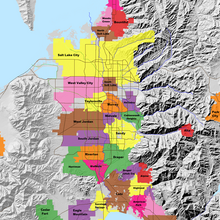
Map of the Salt Lake Valley
The river then flows through the middle of the Salt Lake Valley, initially moving through the city of Bluffdale and then forming the border between the cities of Riverton and Draper.[7] The river then enters the city of South Jordan where it merges with Midas Creek from the west. Upon leaving South Jordan, the river forms the border between the cities of West Jordan on the west and Sandy and Midvale on the east. From the west, Bingham Creek enters West Jordan. Dry Creek, an eastern tributary, combines with the main river in Sandy. The river then forms the border between the cities of Taylorsville and West Valley City on the west and Murray and South Salt Lake on the east. The river flows underneath Interstate 215 in Murray. Little and Big Cottonwood Creeks enter from the east in Murray, 21.7 miles (34.9 km) and 20.6 miles (33.2 km) from the mouth respectively. Mill Creek enters on the east in South Salt Lake, 17.3 miles (27.8 km) from the mouth. The river runs through the middle of Salt Lake City, where the river travels underneath Interstate 80 a mile west of downtown Salt Lake City and again underneath Interstate 215 in the northern portion of Salt Lake City. Interstate 15 parallels the river's eastern flank throughout Salt Lake County. At 16 miles (26 km) from the mouth, the river enters the Surplus Canal channel. The Jordan River physically diverts from the Surplus Canal through four gates and heads north with the Surplus Canal heading northwest. Parley's, Emigration, and Red Butte Creeks converge from the east through an underground pipe, 14.2 miles (22.9 km) from the mouth.[7] City Creek also enters via an underground pipe, 11.5 miles (18.5 km) from the river's mouth. The length of the river and the elevation of its mouth varies year to year depending on the fluctuations of the Great Salt Lake caused by weather conditions. The lake has an average elevation of 4,200 feet (1,300 m) which can deviate by 10 feet (3.0 m).[3] The Jordan River then continues for 9 to 12 miles (14 to 19 km) with Salt Lake County on the west and North Salt Lake and Davis County on the east until it empties into the Great Salt Lake.[7][8][11]
Discharge[edit]
The United States Geological Survey maintains a stream gauge in Salt Lake City that shows annual runoff from the period 1980–2003 is just over 150,000 acre-feet (190,000,000 m3) per year or 100 percent of the total 800,000 acre-feet (990,000,000 m3) of water entering the Jordan River from all sources. The Surplus Canal carries almost 60 percent of the water into the Great Salt Lake, with various irrigation canals responsible for the rest. The amount of water entering the Jordan River from Utah Lake is just over 400,000 acre-feet (490,000,000 m3) per year. Inflow from the 11 largest streams feeding the Jordan River, sewage treatment plants, and groundwater each account for approximately 15 percent of water entering the river.[13]
Watershed[edit]
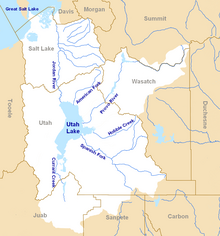
Map of the entire Jordan River Basin
|
|
|
 Premier
Premier
 Précédent
2 a 6 de 6
Suivant
Précédent
2 a 6 de 6
Suivant
 Dernier
Dernier

|
|
| |
|
|
©2025 - Gabitos - Tous droits réservés | |
|
|








 Wednesday, April 15, 2009
Wednesday, April 15, 2009